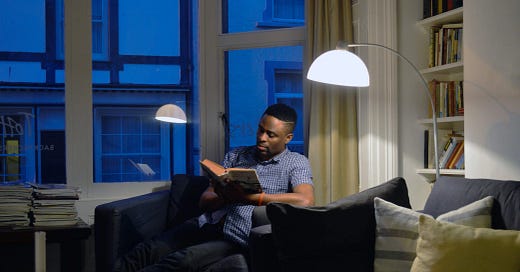Unsplash Photo Credit: Tolu Akinyemi
Proper lighting when reading books is something most of us take for granted, often not realizing its profound impact on our ability to concentrate, comprehend, and retain information.
My journey into the world of optimal lighting began during my undergraduate days at The Ohio State University, where a simple change in my study environment led to a remarkable improvement in my academic performance.
Back then, I was like many college students—cramming late at night with a dim desk lamp or under the harsh glare of fluorescent lights in the library. My GPA was average, and I struggled with eye strain, headaches, and fatigue.
During a study skills workshop, a presenter discussed the science behind proper lighting and its effects on reading and cognition. Intrigued, I decided to delve deeper into this seemingly mundane topic.
The Science Behind Reading and Lighting
Reading is a complex process that engages various parts of our brain, eyes, and cognitive functions. The quality of light significantly affects these processes. There are several key factors to consider when it comes to lighting for reading:
💡Brightness and Contrast: Adequate lighting ensures that the contrast between the text and the background is clear, which reduces the strain on your eyes. Low light levels can cause your pupils to dilate, making it harder for your eyes to focus. Conversely, overly bright light can create glare, which also hampers readability.
💡Color Temperature: The color temperature of light is measured in Kelvin (K). Warm light (around 2700K-3000K) tends to be more relaxing, making it suitable for general living spaces. However, cooler light (around 4000K-5000K) is closer to daylight and can enhance alertness and concentration, making it ideal for reading and studying.
💡Consistency of Lighting: Flickering or inconsistent lighting can cause significant eye strain and discomfort. High-quality LED or halogen lights provide steady illumination, which is essential for prolonged reading sessions.
💡Direction and Spread of Light: Direct lighting that casts shadows can make reading difficult. Diffused lighting that spreads evenly across your reading material is ideal. Desk lamps with adjustable arms and diffusers are particularly useful for directing light where it's needed without causing glare.
My Personal Discovery and Transformation
Inspired by the insights from the study skills workshop, I decided to experiment with different lighting setups. I invested in a high-quality desk lamp with adjustable brightness and color temperature settings. I also rearranged my study space to ensure that natural light from a nearby window complimented my artificial lighting.
The results were almost immediate and striking. The eye strain that had plagued me for so long diminished significantly. I also found that I could study for longer periods without feeling fatigued. My concentration improved, and I retained information more effectively.
One of the most surprising benefits was the positive impact on my sleep. Previously, studying under dim lights late into the night had disrupted my sleep patterns. With proper lighting, I found it easier to transition to a restful sleep after my study sessions. This, in turn, improved my overall well-being and academic performance.
The Impact
With my new lighting setup, my study habits transformed. I became more organized, more disciplined, and more engaged with my coursework. The clarity and focus I gained from proper lighting allowed me to tackle challenging subjects with greater ease. My GPA, which had been hovering around the average mark, saw a significant increase.
My improved study environment not only enhanced my academic performance but also boosted my confidence. I became more active in class discussions and more willing to take on complex projects. The knowledge that a simple adjustment to my lighting could have such a profound effect on my learning experience was empowering.
Flipping On The Switch
Proper lighting for reading is not just a matter of comfort—it's a crucial component of effective study habits and personal success. The science behind it is clear: adequate brightness, appropriate color temperature, consistent illumination, and proper direction of light all play vital roles in enhancing our reading experience.
My discovery during my undergraduate days at Ohio State University was a turning point. It taught me the importance of paying attention to the seemingly small details in our environment that can make a significant difference in our performance and well-being.
Today, I continue to prioritize proper lighting in all my reading and study spaces, and I encourage you to do the same. The right light can truly illuminate the path to knowledge.
Join Us as a Great Books, Great Minds Supporting Member
Since January of 2020, Great Books, Great Minds has provided subscribers community, connection and conversation around books for free—no paywall. But our future relies on you. At $6.00/month or $60.00 per year, please help us sustain our vision of impacting one million readers worldwide by 2030.







This is very interesting. I will assess my lighting. Thanks.
This is something I may have felt intuitively but didn’t know. Thank you for the clarification! Will reassess my space too!